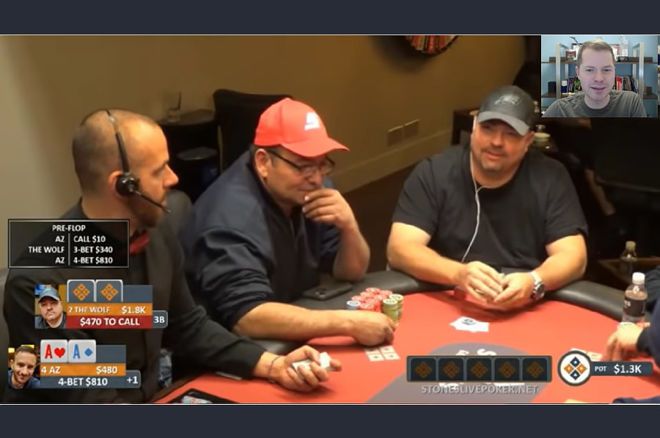Small Stakes Poker Tournaments Jonathan Little
Card Player Magazine, available in print and online, covers poker strategy, poker news, online and casino poker, and poker legislation. Sign up today for a digital subscription to access more than 800 magazine issues and get 26 new issues per year!
Find many great new & used options and get the best deals for Strategies for Beating Small Stakes Poker Tournaments by Jonathan Little (2015, Trade Paperback) at the best online prices at eBay! Free shipping for many products!
I was recently told about a hand from a $1-$3 no-limit hold’em cash game that illustrates a few flaws in the strategy of many recreational players. From second position, an unknown player raised to $15 out of his $500 effective stack and our Hero decided to call from third position with 5 4.
- Crushing Small Stakes Poker Tournaments Volume 01 book. Read reviews from world’s largest community for readers. This poker book made up entirely of 50 u.
- Buy Strategies for Beating Small Stakes Poker Tournaments by Little, Jonathan online on Amazon.ae at best prices. Fast and free shipping free returns cash on delivery available on eligible purchase.
Right from the start, Hero’s call is a clear mistake. While Hero may think that he has a decent chance to get paid off if he makes a straight or a flush, in reality, it takes two incredibly premium post-flop hands in order to get all-in for 167 big blinds. When Hero improves to a strong hand (which will often be a bad flush or a bad straight), if a lot of money goes in the pot, he will frequently be crushed by a better made hand. In general, you should only see the flop with junky drawing hands when you are able to see the flop cheaply (here it costs five big blinds, which is quite costly) and when you stand to win a large pot if you improve to an effective nut hand (which is not the case with weak “premium” made hands like bad flushes and straights).
Strategies for Beating Small Stakes Poker Tournaments (Audio Download): Amazon.co.uk: Jonathan Little, Jonathan Little, Jonathan Little: Audible Audiobooks. The methods required are far from obvious or intuitive but in Mastering Small Stakes No-Limit Hold’em Jonathan Little explains them in great detail. Jonathan constructs a basic strategy to crush small stakes games and also identifies the adjustments that need to be made when facing more competent opposition. You need this book if.

As played, the players in the hijack, cutoff, button, and big blind all called. The flop came K 7 2, giving Hero a weak flush draw. The big blind and initial raiser checked to Hero, who bet $50 into the $91 pot.
I am fine with this bet, although I would usually bet larger, about $70. You want to bet with your best made hands and your draws because it makes you relatively difficult to play against because your opponents have no way of knowing if you have a premium made hand or an unmade draw. That said, when so many players see the flop, it is somewhat likely that Hero is against a bigger flush draw, so he should consider proceeding with caution.
Only the big blind called Hero’s bet. The turn was the 6, giving Hero a flush. The big blind checked and Hero bet $75 into the $191 pot.
I would have again preferred a slightly larger bet size, perhaps $100, but $75 could be ideal if Hero thinks he is against a range consisting of mostly marginal made hands that will only call a small bet. One of the key skills you must master to beat small stakes cash games (as I discuss in my book Mastering Small Stakes No-Limit Hold’em) is to choose the optimal bet size to achieve the result you want. Hero wants to get called by all the marginal made hands while also pricing out the obvious draws, such as A 5. A slightly larger bet of $100 will usually get called by any king and some middle pairs with flush draws while also charging the draws a bit more to see the river.

The big blind called. The river was the 10. The big blind checked.
As on the turn, Hero should choose a bet size that is likely to be called by worse made hands. At this point, the only realistic made hand that is worse than Hero’s that can call a river bet is top pair, and even then, it cannot call a large bet. So, Hero should choose a somewhat small bet size. I think Hero’s $150 bet may be a bit too large. When facing a river bet, some players only call with two pair or a better hand.
Given the big blind should have relatively few two pairs and sets, most of his river calling range could easily be flushes, which should lead Hero to consider checking behind or betting small.
Hero bet $150 into the $341 pot. The big blind folded, giving Hero the pot.
Even though Hero made a premium hand, he only won $200. While winning $200 is great, it is far from amazing. When you are fortunate enough to make a premium post-flop hand, you want to be sure to get paid off for as much as possible. This time, Hero could only go for a small amount of value because if he bet any larger, he would almost certainly only get called when he was beat. ♠

Jonathan Little is a professional poker player and best-selling poker author with over $6,900,000 in live tournament earnings. If you want to learn how to play fundamentally sound poker and increase your win rate, check out PokerCoaching.com. Click here to try PokerCoaching.com for free.